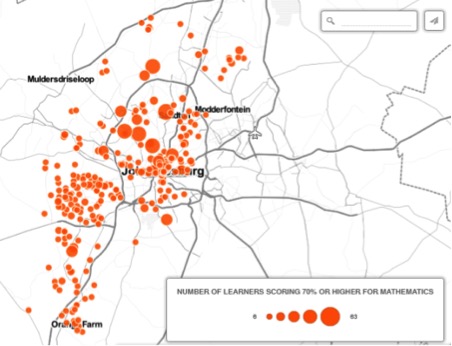The media and the general public often find it difficult to interpret or analyse the state of public education.
The South African government spends more on basic education than on any other department or area, but public education outcomes have been ranked among the worst in the world. There are many possible contributing factors to these poor outcomes but little political will to fix the problems.
The media and the general public often find it difficult to interpret or analyse the state of public education. There is not much information available in a format that can be easily interpreted or understood by non-specialists. Most analysis of schools’ performance is limited to annual matric (Grade 12) results, and even then this analysis focuses mainly on overall pass rates that are aggregated at the national or provincial level.

There is so much more public education data that’s potentially available: detailed matric results by subject and mark obtained, number of learners and teachers, all of it down to the school level.
For schools, there’s information on sizes, household income levels, relevant contact details and (particularly useful for geospatial analysis) their locations. There’s detailed information for the learners: age, home language, disabilities and whether they’ve been held back a year.
This information exists across many different spreadsheets and websites. Much of it is difficult to access and to understand. If the information can be made available on phones and laptops, using maps and dashboards, understanding of basic education would be greatly enhanced.

The Mail & Guardian and EDGIS have partnered to create DataEducator. We’ve cleaned matric results information for almost 300 high schools in the City of Johannesburg metro for four academic years (2012 to 2015) and we’ve created visualisations of these results using CARTO. Some of these have been used in articles (such as this one on matric Mathematics results) and viewed by thousands of people.
There’s an obvious benefit to the media. We can tell better stories with the data by focusing on a particular school district, a school, academic subject or learner cohort. Rather than just talking about overall matric results, we can report on trends in Geography in a certain district, whether older students are more or less likely to pass Grade 9, and if schools in Diepsloot are tackling overcrowding or not.
The stories told can move beyond being descriptive and can become more investigative and predictive. An example: by overlaying demographic data from the national census, we can compare the number of children aged 5 to 19 in a particular area with the number of learners enrolled in basic education – and we can make that area as geographically specific as a district, municipality, or even ward. Now we can report on the supply of basic education opportunities in specific areas.
Another example: with the data available we can compare the home language of learners with a school’s language of learning and tuition (LOLT) and see how the relationship between the two affects education outcomes. Now the media can create an informed debate over the benefits of mother-tongue education.
This tool has the potential to go far beyond telling better stories and shaping public narratives around education. It can also be a platform to gather and present other information outside of the public sector. Communities, non-profit organisations, and private schools can tell us about their needs and the effects of their interventions. Private donors and businesses can link directly to schools if they want to donate or assist them.
South Africa is hungry for better insights and higher standards in basic education. If you would like to improve basic education in South Africa, please support us on social media by mentioning this project and using the hashtag #innovateAFRICA.